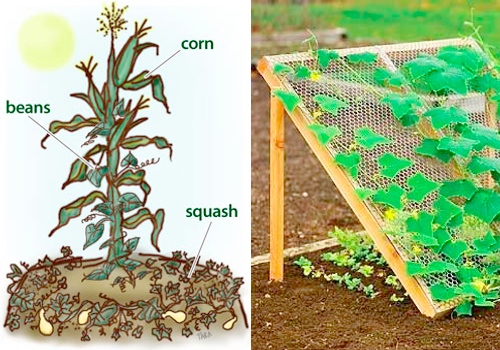Welcome to Part 3 of our series on veganic gardening. Click here to see the whole series. Subscribe to this blog to make sure you don’t miss future posts.
Even if you didn’t spend your winter “plotting” and planning your springtime gardening, you can still take some time to map out which plants will go where (and when) in your veganic garden. Doing so will help you make the most of the space and time available to you.
All gardening involves some disturbance of ecosystems. Veganic gardeners try to cause the least harm possible, by making the most of every inch. This is also an especially “eco” way to garden, as it tends to require less water while producing a surplus of crops. But it requires a bit of planning.
So, pace off the space(s) in which you’ll be gardening, then grab some graph paper or a ruler and some scratch paper. Then sit down and sketch a rough map of where (and when) you’ll plant what, keeping the following principles in mind:
Let Your Plants Get to Know Each Other
In general, you will want to space your plants so that, when mature, their leaves will just touch each other. In other words, so that they won’t be crowded together but also won’t be each isolated with a patch of bare earth (that will have to be constantly weeded) around it. As they grow, the plants will shade the space between them, inhibiting the growth of unwanted plants (aka “weeds”) while keeping the soil moist. But—uh oh!—if you grow a lot of the same kind of plants close together, that makes it easy for diseases or insects that like that plant to hop from one to the other. So…
Say No to Rows
Instead of rows, organize your crops in mixed-plant groupings of crops that get along with each other. For example, you might have a few groupings including one tomato plant and a couple of pepper plants, with some basil grown among them. (Yum—they taste good together too!) And of course, there’s always the corn-bean-squash grouping that is the true traditional American agriculture, having been practiced by native peoples across the Americas long before the conquest. In that grouping, the corn stalks provide support for the bean vines while the spike-y squash vines and leaves of the squash plants keep the soil moist and deter insects. What do the beans contribute? Their roots fix nitrogen in the soil, making it more fertile for the other two. Which brings us to the next principle of effective veganic gardening…
Say Yes to Intercropping
Intercropping is the practice of deliberately encouraging beneficial relationships among plants. For example, cool season plants (e.g., radishes, lettuce, etc.) start to wilt or bolt once the weather gets hot, even if they haven’t reached maturity. Wouldn’t it be nice if they had some shade? Remember that tomato plant? It will start out as a small seedling. If, when you transplant it, you sow some radishes in the area around it, they will have full sun until the tomato plant gets bigger, at which point they will be needing some shade. By the time the tomato really needs that space, it’s time to harvest the radishes anyway! Similarly, what if you grew your lettuce under a trellis on which cucumbers or beans will be growing? Which brings us to one of the most important keys to effective veganic gardening: using vertical space.
Get Vertical
While your garden ground space is sharply circumscribed, the sky’s the limit when it comes to growing vertically. So, choose vining varieties of beans, cukes, and squash. (Seed packets will tell you whether cuckes or beans are “bush” or “pole” varieties and will describe the growing habits of squash.) There are even climbing varieties of greens and—believe it or not—cherry tomatoes. How will you support all of these vines? First, look around and see whether you have some fences or other climbing surfaces (in or outside of your formal “garden”) where you might pop a few plants. Next, look around for materials you might use to make DIY trellises and tepees of different shapes and sizes. (Go googling for inspiration.) Twine and tree branches (or scrap lumber) may be all you need. If you must buy some supplies, choose sustainable materials like hemp twine and bamboo.
Improvise
Here at VINE, we use our own scrap materials as well as what we find at the dump to make a variety of garden structures and supplies. We try new varieties and different configurations of plants, knowing that we’ll get another chance next year if this year’s experiments don’t work out as planned. When “volunteer” plants pop up where we didn’t plant them, we let them grow, to see what they will become. We encourage you to take a similarly improvisational and adventurous approach to what should be a fun and energizing activity. Yes, you will tend, on average, to have higher yields if you put some planning and information gathering into the process. But, as everybody knows, “the best-laid schemes o’ mice an’ men” so often go awry anyway. (There was that time, here, when bovines burst the fence into Cheryl and Kathy’s vegetable garden, consuming a season’s worth of would-be produce in what can only be called a cowpocalypse.) So, we hope you will approach the prescriptions above with a jaunty spirit of trial-and-error rather than making a labor of it.
You can find lots of specific information about applying the principles above when growing specific crops by searching for phrases such as “small space gardening,” “intensive gardening,” or “square foot gardening.”
Next up in our veganic gardening series: Groundwork (fertilizers and soil amendments). Stay tuned.




